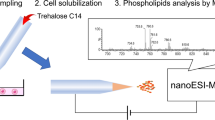Abstract
Accumulation of lysosomal phospholipids in cells exposed to cationic amphiphilic drugs is characteristic of drug-induced phospholipidosis. The morphological hallmark of phospholipidosis is the appearance of unicentric or multicentric-lamellar bodies when viewed under an electron microscope (EM). The EM method, the gold standard of detecting cellular phospholipidosis, has downsides, namely, low-throughput, high-costs, and unsuitability for screening a large chemical library. This chapter describes a cell-based high-content phospholipidosis assay using the LipidTOX reagent in a high-throughput screening (HTS) platform. This assay has been optimized and validated in HepG2 and HepRG cells, and miniaturized into a 1536-well plate, thus can be used for high-throughput screening (HTS) to identify chemical compounds that induce phospholipidosis.
Access this chapter
Tax calculation will be finalised at checkout
Purchases are for personal use only
Similar content being viewed by others
References
Breiden B, Sandhoff K (2019) Emerging mechanisms of drug-induced phospholipidosis. Biol Chem 401(1):31–46. https://doi.org/10.1515/hsz-2019-0270
Oikawa H, Maesawa C, Sato R, Oikawa K, Yamada H, Oriso S, Ono S, Yashima-Abo A, Kotani K, Suzuki K, Masuda T (2005) Liver cirrhosis induced by long-term administration of a daily low dose of amiodarone: a case report. World J Gastroenterol 11(34):5394–5397
Reasor MJ, Kacew S (1996) An evaluation of possible mechanisms underlying amiodarone-induced pulmonary toxicity. Proc Soc Exp Biol Med 212(4):297–304
Ruben Z, Dodd DC, Rorig KJ, Anderson SN (1989) Disobutamide: a model agent for investigating intracellular drug storage. Toxicol Appl Pharmacol 97(1):57–71
Kaloyanides GJ, Pastoriza-Munoz E (1980) Aminoglycoside nephrotoxicity. Kidney Int 18(5):571–582
Casartelli A, Bonato M, Cristofori P, Crivellente F, Dal Negro G, Masotto I, Mutinelli C, Valko K, Bonfante V (2003) A cell-based approach for the early assessment of the phospholipidogenic potential in pharmaceutical research and drug development. Cell Biol Toxicol 19(3):161–176. https://doi.org/10.1023/a:1024778329320
Gum RJ, Hickman D, Fagerland JA, Heindel MA, Gagne GD, Schmidt JM, Michaelides MR, Davidsen SK, Ulrich RG (2001) Analysis of two matrix metalloproteinase inhibitors and their metabolites for induction of phospholipidosis in rat and human hepatocytes(1). Biochem Pharmacol 62(12):1661–1673. https://doi.org/10.1016/s0006-2952(01)00823-1
Nioi P, Perry BK, Wang EJ, Gu YZ, Snyder RD (2007) In vitro detection of drug-induced phospholipidosis using gene expression and fluorescent phospholipid based methodologies. Toxicol Sci 99(1):162–173. https://doi.org/10.1093/toxsci/kfm157
Li S, **a M (2019) Review of high-content screening applications in toxicology. Arch Toxicol 93(12):3387–3396. https://doi.org/10.1007/s00204-019-02593-5
Shahane SA, Huang R, Gerhold D, Baxa U, Austin CP, **a M (2014) Detection of phospholipidosis induction: a cell-based assay in high-throughput and high-content format. J Biomol Screen 19(1):66–76. https://doi.org/10.1177/1087057113502851
Slavov S, Stoyanova-Slavova I, Li S, Zhao J, Huang R, **a M, Beger R (2017) Why are most phospholipidosis inducers also hERG blockers? Arch Toxicol 91(12):3885–3895. https://doi.org/10.1007/s00204-017-1995-9
Acknowledgments
This work was supported, in part, by the Intramural research program of the NCATS, NIH.
Author information
Authors and Affiliations
Corresponding author
Editor information
Editors and Affiliations
Rights and permissions
Copyright information
© 2022 This is a U.S. government work and not under copyright protection in the U.S.; foreign copyright protection may apply
About this protocol
Cite this protocol
Zhang, L., Li, S., **a, M. (2022). Cell-Based Imaging Assay for Detection of Phospholipidosis. In: Zhu, H., **a, M. (eds) High-Throughput Screening Assays in Toxicology. Methods in Molecular Biology, vol 2474. Humana, New York, NY. https://doi.org/10.1007/978-1-0716-2213-1_8
Download citation
DOI: https://doi.org/10.1007/978-1-0716-2213-1_8
Published:
Publisher Name: Humana, New York, NY
Print ISBN: 978-1-0716-2212-4
Online ISBN: 978-1-0716-2213-1
eBook Packages: Springer Protocols




